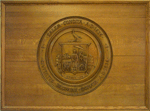Larcom, Lucy: Difference between revisions
From Salem Links and Lore
No edit summary |
No edit summary |
||
| (5 intermediate revisions by the same user not shown) | |||
| Line 1: | Line 1: | ||
Lucy Larcom wrote a poem, the Arbella for the Winthrop Field Meeting. | Lucy Larcom wrote a poem, the [[Arbella]], for the Winthrop Field Meeting. | ||
It is found in the Essex Institute Collection, Vol. 17, p. 221-223 | It is found in the Essex Institute Collection, Vol. 17, p. 221-223 | ||
Leaving her Beverly home at age 11, she went to work in the cotton mills in Lowell hoping to earn some extra money for her family. She made a huge impact during her 10 years there; she wrote many songs, poems, and letters describing the mill-girl life, and got them published, and her idealistic poems were recognized. | |||
Larcom died at age 69 on April 17, 1893 in Boston and was buried in her hometown of Beverly, Massachusetts. | |||
| Line 7: | Line 11: | ||
==See Also== | ==See Also== | ||
[http://evergreen.noblenet.org/eg/opac/record/1778659?locg=63 Lucy Larcom: life, letters and diary] | |||
[http://salem.noblenet.org/eg/opac/record/2382888?query=essex%20institute%20historical%20collection;qtype=keyword;locg=63 Essex Institute Historical Collection] Vol. 17, p. 221-223 | [http://salem.noblenet.org/eg/opac/record/2382888?query=essex%20institute%20historical%20collection;qtype=keyword;locg=63 Essex Institute Historical Collection] Vol. 17, p. 221-223 | ||
Latest revision as of 14:36, 4 November 2020
Lucy Larcom wrote a poem, the Arbella, for the Winthrop Field Meeting. It is found in the Essex Institute Collection, Vol. 17, p. 221-223
Leaving her Beverly home at age 11, she went to work in the cotton mills in Lowell hoping to earn some extra money for her family. She made a huge impact during her 10 years there; she wrote many songs, poems, and letters describing the mill-girl life, and got them published, and her idealistic poems were recognized.
Larcom died at age 69 on April 17, 1893 in Boston and was buried in her hometown of Beverly, Massachusetts.
See Also
Lucy Larcom: life, letters and diary
Essex Institute Historical Collection Vol. 17, p. 221-223
